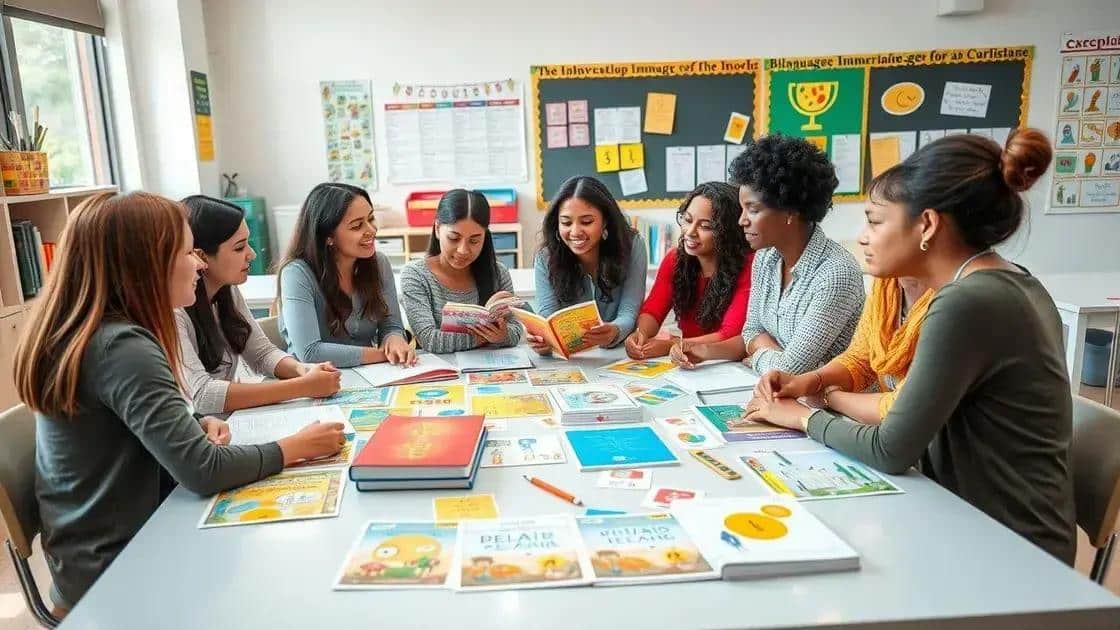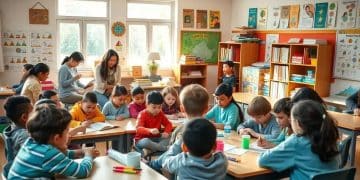Dual-language immersion program development: boost education

A dual-language immersion program enhances bilingualism and cultural understanding through integrated teaching in two languages, leading to improved cognitive skills and academic performance for students.
Dual-language immersion program development is becoming increasingly popular in today’s education landscape. Have you ever wondered how these programs can transform students’ learning experiences? Let’s dive into the essential elements that make them effective.
Understanding dual-language immersion programs
Understanding dual-language immersion programs is crucial for educators and parents alike. These programs aim to teach students in two languages, promoting bilingualism and cultural appreciation.
What are dual-language immersion programs?
In simple terms, dual-language immersion programs combine native language instruction with a second language. This approach allows students to develop fluency in both languages. Typically, students spend part of their day learning in English and part in another language, such as Spanish or Mandarin.
Key Features
- Balanced Instruction: Instruction is provided in both languages, ensuring that students receive equal exposure.
- Cultural Integration: These programs encourage cultural understanding and respect among students.
- Age-Appropriate Learning: Programs are designed for students of various age groups, enhancing their learning experience.
- Community Engagement: Many programs involve families and communities to support cultural connections.
Students in these programs often perform better academically than their peers in traditional programs. This is because learning in a second language enhances cognitive skills. Research shows that bilingual students are more likely to excel in problem-solving and critical thinking.
In addition to cognitive benefits, dual-language immersion programs foster social skills. Students learn to communicate effectively in diverse settings and build friendships across cultural boundaries. This skill set is essential in today’s global society.
Why Choose Dual-Language Immersion?
Choosing a suitable educational path is essential for every child. Dual-language immersion programs are an excellent choice for parents looking to prepare their children for a global future. Besides language skills, these programs cultivate adaptability and open-mindedness.
As children navigate both languages, they gain confidence and a sense of identity. This unique opportunity helps them appreciate different cultures and perspectives.
Overall, understanding dual-language immersion programs can empower you to make informed choices about your child’s education. Embracing this learning model can unlock a wealth of opportunities for their future.
Benefits of bilingual education
Bilingual education offers numerous benefits that extend beyond mere language acquisition. At its core, it allows students to develop proficiency in two languages, which can open doors to a multitude of opportunities.
Enhanced Cognitive Skills
Studies show that bilingual students often excel in critical thinking and problem-solving. Learning in different languages encourages them to view challenges from various perspectives, enhancing their cognitive flexibility.
Improved Academic Performance
Research indicates that students in bilingual programs tend to perform better in standardized tests compared to their monolingual peers. This can be attributed to their ability to process information in multiple languages. They also develop a deeper understanding of their primary language.
- Stronger Reading Skills: Bilingual education enhances literacy skills in both languages.
- Increased Cultural Awareness: Students learn to appreciate and respect diverse cultures.
- Higher Employment Opportunities: Bilingual individuals are often more competitive in the job market.
- Long-term Academic Success: Bilingualism is linked to greater academic achievement throughout a child’s education.
Furthermore, bilingual education fosters social skills. Students learn to communicate with a wider range of people, building friendships across cultural lines. This social competence is invaluable in our increasingly globalized world.
The benefits of learning in a bilingual environment are evident. Students do not just gain language skills; they develop a global mindset. This prepares them for life beyond the classroom, equipping them to navigate diverse societies.
Ultimately, embracing bilingual education can create well-rounded individuals capable of thriving in a multicultural environment. The skills they acquire will serve them for years to come, both socially and professionally.
Key components of effective program development

Creating an effective dual-language immersion program involves several key components. These elements work together to ensure that the program meets its educational goals and serves the needs of all students.
Curriculum Design
First and foremost, a well-structured curriculum is essential. It should align with educational standards and incorporate both languages seamlessly. This design helps students see connections between their learning experiences.
Qualified Educators
Having qualified teachers who are fluent in both languages is another crucial aspect. Educators should not only understand the languages but also be trained in effective teaching strategies for bilingual learners. This ensures that students receive high-quality instruction.
- Professional Development: Ongoing training for teachers is key to enhancing their skills.
- Language Proficiency: Teachers must maintain high levels of proficiency in both languages for effective communication.
- Cultural Competence: Educators should understand and respect the cultures associated with the languages.
- Collaborative Teaching: Team teaching can help leverage the strengths of different educators.
Another important component is family and community involvement. Engaging families supports students’ learning and fosters a sense of belonging. When families are active participants, they reinforce language skills at home.
Moreover, strong assessments are vital to monitor student progress. Regular evaluations help identify areas where students may need additional support. Effective assessment strategies include both formative and summative assessments, allowing for a comprehensive view of student achievement in both languages.
Finally, clear communication among all stakeholders contributes significantly to the program’s success. Establishing transparent channels for feedback and updates ensures that parents and community members remain informed and invested in the program’s development.
Challenges in implementing dual-language strategies
Implementing dual-language strategies presents several challenges that educators must navigate. Understanding these hurdles is essential for creating effective programs that benefit all students.
Resource Allocation
One significant challenge is the allocation of resources. Many schools struggle to provide the necessary materials and trained staff for bilingual education. Ensuring that classrooms are equipped with appropriate educational tools in both languages is vital.
Teacher Training
Teacher training is another critical factor. Educators must be proficient in both languages and understand the pedagogical approaches suitable for bilingual instruction. Finding teachers who meet these criteria can be difficult, especially in areas with limited access to qualified candidates.
- Professional Development: Ongoing professional development is essential for keeping teachers updated on best practices.
- Language Proficiency: Teachers need to maintain high language proficiency in both languages to provide quality instruction.
- Support Networks: Establishing support networks among teachers can help share resources and strategies.
- Recruitment Efforts: Schools may need to implement targeted recruitment strategies to attract qualified bilingual educators.
Additionally, community and family involvement can pose challenges. While parental engagement is essential, not all families may be familiar with the dual-language model or feel comfortable supporting bilingual education at home. Educating parents about the benefits and communicating effectively can help bridge this gap.
Another challenge is balancing language exposure. It is important for students to receive equal instruction in both languages; however, achieving this balance can be difficult. Schools often face pressure to prioritize one language over the other, which can undermine the program’s effectiveness.
Finally, assessing student progress in two languages can be complex. Educators must develop effective evaluation methods that consider students’ achievements in both languages, ensuring a fair assessment of their skills.
Success stories of dual-language immersion initiatives
Success stories of dual-language immersion initiatives highlight the positive impact these programs can have on students. Schools around the world are experiencing transformative changes, fostering bilingualism and cultural appreciation.
Case Study: California’s Bilingual Programs
In California, many schools have adopted bilingual programs that show remarkable results. Schools like the San Francisco Unified School District have embraced dual-language immersion, leading to increased student performance in both English and Spanish. Students in these programs have demonstrated higher levels of academic achievement as they balance the demands of two languages.
Success in New York City
In New York City, dual-language programs have expanded significantly. Schools such as PS 57, which offers Mandarin-English immersion, report strong student engagement and community support. Families are excited about the opportunity for their children to become fluent in two languages. This not only enhances academic skills but also prepares students for global citizenship.
- Student Testimonials: Many students express confidence in their abilities to speak two languages.
- Community Involvement: Parents and community members actively participate in school activities, fostering support.
- Academic Performance: Students often outpace their peers in standardized tests.
- Cultural Exchange: Students gain a deep appreciation for diverse cultures.
In Miami, a dual-language initiative has been particularly successful in bridging cultural divides. The program fosters understanding among diverse student populations, promoting harmony and collaboration. Students from various backgrounds come together, learning to communicate and collaborate effectively.
Furthermore, research backs these success stories. Studies indicate that bilingual students often outperform monolingual peers in critical thinking and problem-solving skills. This advantageous skill set opens many opportunities for future academic and professional success.
Success stories like these illustrate how dual-language immersion initiatives benefit not only students and families but also entire communities. As these programs continue to grow, they show that investing in bilingual education can lead to lasting positive changes for future generations.
In summary, dual-language immersion programs present numerous benefits, including improved cognitive skills and cultural awareness. Success stories from various schools showcase the positive impact on students’ academic performance and social development. Although challenges exist, such as resource availability and teacher training, the results demonstrate the value of investing in bilingual education. Embracing these programs paves the way for a brighter, more inclusive future for our students, enabling them to thrive in an increasingly interconnected world.
FAQ – Frequently Asked Questions about Dual-Language Immersion Programs
What are the main benefits of dual-language immersion programs?
Dual-language immersion programs enhance cognitive skills, improve academic performance, and foster cultural awareness among students.
How do these programs support cultural exchange?
These programs promote interaction among students from diverse backgrounds, allowing them to learn from each other and appreciate different cultures.
What challenges do schools face when implementing dual-language strategies?
Challenges include resource allocation, qualified teacher training, and balancing language exposure in the curriculum.
How can parents support their children’s dual-language education?
Parents can reinforce language skills at home by engaging in bilingual activities, reading together in both languages, and participating in school events.





